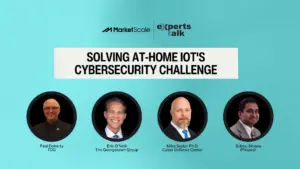IoT in Healthcare Is a Step in the Right Direction for Wider Adoption in the U.S.
If the U.S. wants to accelerate adoption, looking at IoT in Healthcare and untapped areas of potential may be the perfect place to start.
The National Institute of Standards and Technology (NIST) recently called for feedback on the progress of a federal working group dedicated to the strategic pillars of Internet of Things (IoT) technology. Established by Congress in 2020, this group’s mission is to provide actionable recommendations to the Federal government, promoting the seamless integration of IoT technologies. Their focus extends beyond mere adoption, delving into IoT’s safe and secure utilization, protecting critical infrastructure, and fortifying Federal systems against IoT-related cyber threats. With a deadline set for September 25, NIST’s “Preliminary Update from the Internet of Things Federal Working Group” aims to gather insights to shape future federal actions in IoT development and deployment. This initiative marks a pivotal step in the U.S.’s journey toward a more connected and technologically advanced future.
What specific strategies can the U.S. implement to accelerate IoT adoption further and ensure widespread integration across various sectors?
Iain Murray, John Curtin Distinguished Professor and Deputy Head of EECMS at Curtin University says the U.S. should capitalize on IoT in healthcare, where technology innovations occur rapidly, and in areas where IoT makes perfect sense.
Iain’s Thoughts
“Security is often treated as an afterthought or not considered at all. This is particularly true in the industrial sector, where, traditionally, everything has been air-gapped, leading to a lack of concern about device security. This is an area that urgently needs attention, possibly with the introduction of standards to ensure both device and communication security.
Another aspect to consider is education. Questions arise about the applications of these devices: Where can we use them? How do they fit into society and our daily lives? Interoperability standards are also a challenge. While we have standard protocols to communicate with these devices, the meaning and interpretation of the data they produce remain ambiguous.”
Trailblazer Initiative and the Mining Industry’s IoT Evolution
“There have been some developments in this area. Significant government investment has been made in research and development, particularly in linking universities to industries. One such initiative is Trailblazer, which encourages collaboration between universities and the mining industry. Many projects under Trailblazer revolve around IoT, such as remote sensing and operations. Given Australia’s vast geographic distances, like the immense size of Western Australia, remote operations are crucial. Mine sites might be hundreds of miles away, yet they rely on IoT for everything from self-driving trucks to automatic loading.
This need for remote operations extends to the consumer sector. Consider the FIFO (Fly In, Fly Out) workers who spend days at a mine site and then return to cities like Perth. All their living needs, from accommodation to power generation, are monitored and managed from locations thousands of kilometers away, thanks to IoT.”
Expanding IoT in Healthcare and Innovative Applications
“The health sector is also benefiting. Remote communities, especially indigenous ones, are hours away from the nearest town. IoT is being used to provide telehealth support to these communities. One of the standout benefits in Australia is the ability to operate remotely. This is particularly impactful in medical systems. A specialist in Dallas, Texas, can treat a patient in New York using IoT technologies to monitor vital signs and even conduct telerehabilitation.
There are other innovative applications as well. For instance, guide dogs have been turned into IoT devices. These dogs are equipped with sensors, cameras, and GPS to monitor their health and performance. This not only ensures the safety of the vision-impaired individual but also provides real-time data on the dog’s health and activities. The system integrates with other platforms like weather apps and Google Maps to provide comprehensive support to the user.”
Article by James Kent








